Abdulrahman Ilyas Saleh, Bahar Başer Kalyoncuoğlu
Istanbul Okan University, Institute of Sciences and Architecture, Istanbul, Turkey
Correspondence to: Abdulrahman Ilyas Saleh, Istanbul Okan University, Institute of Sciences and Architecture, Istanbul, Turkey.
| Email: |  |
Copyright © 2020 The Author(s). Published by Scientific & Academic Publishing.
This work is licensed under the Creative Commons Attribution International License (CC BY).
http://creativecommons.org/licenses/by/4.0/

Abstract
Throughout history, urban green space has been considered as an essential part of cities. Green spaces have continuously reflected the complexities of cities’ cultural and social contexts. Moreover, green spaces have been considered as indicators of both quality of life and urban sustainability. Social diversity will have a major impact on the development of cities in the future; it is significant to incorporate the impact of demographic shifts and biodiversity into urban green spaces planning. From this perspective, it is clear that urban green spaces also provide multiple ecosystem service benefits to diverse social groups. In this study, it is aimed to evaluate the diverse inhabitant perceptions of cultural ecosystem services provided by the urban park in the city of Istanbul, based on on-site observation and questionnaire techniques. The research methodology aims to decode the features of urban public space, focusing on people’s activities and various forms of use-from passive to active engagement to understand the activity-physical pattern relationships in a selected urban public space. Based on questionnaire distribution, as an analysis tool, it has focused on non-monetary statements on the perceived importance of a wide scale of cultural ecosystem services and used the chi-square method for cluster sampling. Results show that both groups (native and foreign) viewed cultural diversity as the most important cultural ecosystem service, and it shows that cultural ecosystem services can be perceived through bundles and that those bundles have a positive influence on each other. The perceived importance of cultural ecosystem services by social factors was influenced by social factors; (1) native sample groups perceived recreational value ahead of aesthetical value and (2) foreign sample groups perceived aesthetic as more important than recreation. These different perceptions should be used through urban development strategies to create a sustainable city planning in the face of social and environmental changes.
Keywords:
Urban green spaces, Cultural ecosystem services, Social research methods, Taksim Gezi Park, Istanbul
Cite this paper: Abdulrahman Ilyas Saleh, Bahar Başer Kalyoncuoğlu, Comparative Analysis of Perceptional Difference in Cultural Ecosystem Services of Urban Green Spaces: A Case Study in Gezi Park Istanbul, Turkey, Architecture Research, Vol. 10 No. 5, 2020, pp. 117-125. doi: 10.5923/j.arch.20201005.01.
1. Introduction
The population is increasing rapidly, yet the population depends on nature as before, and the increasing density of buildings affects urban ecosystems [2]. Globally, over 50% of the population lives in urban areas, which are expected to increase by 1.5 times to 6 billion by 2045 (World Bank). Urban green spaces have been considered an essential part of cities throughout history. Throughout urban life, green spaces have continued to reflect on the complexities of their cities’ social, cultural, and economic contexts. Green spaces play an important role in the urban quality of life whether memorable, accessible, or meaningful places through an increase in biodiversity. Other benefits of urban green space include the overall health benefit through relaxation and recreation possibilities, cultural ecosystem services contribute highly to urban quality of life. Due to the growing population in urban cities, urban green spaces are under critical development and use pressure; this can lead to low priority on green spaces development and for the planning of green spaces, as increasing populations demand more housing and industrial areas, prompting into challenges for sustainable urban development. The growing need for greener cities has motivated research into the fundamental nature of our cities and the habits that make or break them. Cultural ecosystem services are essential in urban green space planning, as it needs to account for the heterogeneity of urban areas and to improve the social and economic productivity of green spaces and the provided ecosystem services. According to the Millennium Ecosystem Assessment [6], cultural ecosystem services can be defined as the non-material benefits people obtain from ecosystem services e.g. capabilities and experiences [3] through spiritual enhancement, intellectual development, aesthetical, and recreational experiences (MEA 2005). Other ecosystem services (supporting, provision, and regulating) have been investigated more. For the most part, researchers gave more priority to other ecosystem services. Important, yes it is, however, it surely is not and should not be the most determinant factor when designing cities especially urban green spaces. Cultural ecosystem services are still under-research particularly in urban areas [5,10] as they are as equally important as the other ecosystem services in designing and planning of cities. limited knowledge exists on how different social groups value the entire set of cultural services from urban green spaces. the perception of cultural ecosystem services in an environment by social groups is mainly driven by their different cultures and belief systems [4,8]. This poses challenges in the urban setting, where various green space types, social groups, and user demands occur at the same time (Gómez-Baggethun & Barton, 2012). To account for those difficulties, it shows the opinion of the public using on-site observation and questionnaires to account for personal, contextual, and spatial influences on urban CES importance.To assist urban planners and decision-makers in new planning/development strategies to guarantee the sustainability of their urban green spaces. It, therefore, aim to answer: 1) Compare how cultural ecosystem services are perceived in Istanbul/Gezi park, 2) How different cultural ecosystem suggest contrasting preferences between the services, 3) Assess how the socio-demographic (focus groups) status influences the perceived importance of the different cultural ecosystem service features.
2. Methods
2.1. Study Area
The context for this research was the city of Istanbul in Turkey, which is the largest city in Istanbul with a 2019 population estimate of 15.03 million (Turkish statistical institute; Turkish government). Istanbul has undergone considerable changes over the years, particularly upon landscaping and many of the public and green spaces in and around the city center; in addition to numerous residential and business redevelopment projects. The case study of Taksim Gezi Park within the city of Istanbul was selected, Istanbul is known for its international reputation as a business, touristic, and diverse city. Taksim Gezi Park formerly known as İnönu Park was opened in 1943, the park is a city park within the borders of Beyoğlu, and located between Taksim square an Eladağ. The site where the park is located went through some changes throughout the years; it began in 1806 when the Taksim artillery barracks were built. Also, between 1921-1940, the internal courtyard of the barracks served as the first football field in Istanbul due to the high cost of maintenance and repair of the barracks that later became a public park. In 2013, the neo-liberal politician set their eye on the park, the prime minister of that period wanted to build a residential building and a shopping mall on the site where the park is which escalated into a protest under the banner ‘Taksim vigilance’. With the help of the people, Gezi Park continues to live as an indestructive park. The park was designed for recreational purposes and link the surrounding with mixed uses such as shops, restaurants, and public transport. The districts also show a great variety of socio-demographic factors such as age and migration background, the demographic predictions are expected to increase.
2.2. Research Design and Data Analysis
A sequential mixed method combining qualitative and quantitative methods is used to study the cultural ecosystem services provided by urban Green Park in this research. This was selected in other to be able to produce a more comprehensive study than from one method alone but entails the recognition that different methods may produce different answers. Using a mixed-method is key as certain questions are best assessed through quantitative and others through qualitative. Using mixed methods also enables an understanding at different levels of reality, because all social phenomena are multifaceted, a variety of approaches enables an exploration of their complexity. This is a study on categories of urban CES based on questionnaires done in the city of Istanbul. Prior to the questionnaire development, a qualitative study was conducted to understand the study area, and activities are done in the park using field observation. Direct field observation is carried out to detail the type of activities concerning cultural ecosystem services through photography and walking through the space showing and capturing the activity points.A questionnaire was generated to quantitatively assess perceived CES importance. To refine the structure of the questionnaire, we organized two focus groups (native and foreign group) and conducted a pilot study. The questionnaire contained segments on the utilization and preferences of Taksim Gezi Park, perceived importance of CES, and socio-demographic information (Table 1, Table A1). The sampling frame included all users of Istanbul from natives to foreigners. Table 1. Scaling and coding of the variables used in the analysis
 |
| |
|
Data were analyzed using IBM SPSS statistics 22. Missing data were excluded pairwise as missing data and item non-response rates were low.Firstly, I conducted an initial observation to assess the area in terms of where to take pictures to get visibility to the most used points of the site. The inceptive observation allowed inspecting the site to identify areas of activities within the space. Secondly, we examined relations between 5 categories on perceived CES importance of public urban green park using bivariate correlations (Pearson’s r coefficient). Examination of different social aspects influencing CES using chi squere test of each CES on the two focus groups was made. Chi-square tests were conducted which sought to establish the relationships between the two focus groups (native and foreigners) and perception, and use of gezi park.
3. Results
I chose four sub-areas with different design configurations including a) the two areas with fountains, b) a tree-lined and walking path area, c) the two playground areas, d) café area (Figure 2); a) The two areas with fountains; these two areas contain beautiful fountains; people tend to sit around and facing the fountains and enjoy looking at the fountains and relaxing with the soothing sound of the water. In addition, children enjoy playing with the water and users love to take pictures around the fountains. b) A tree-lined and walk path area; Users sit along the tree-lined area to relax, read, and talk with their friends. Furthermore, users use the waking path not just for walking, but also for accessibility, children like to play along the path and some use the path for running/jogging. c) The two playground areas; this space is commonly used by families, children love using this space for the playground, parents sit facing the playground to supervise their children. d) Café area; the café attracts people to use it as it faces the sea area.Among these respondents, 51.4% (38) were native Turkish and 48.6% (36) were foreigners. The number of responses was then decreased to 72 people to have an equal number from both groups. The adjusted and final total number of respondents was 72, each group having a total number of 36 respondents. Amongst these respondents, 34.7% (25) were female and 15.3% (11) were male for the native speakers. Moreover, for the foreigners 8.3% (6) were female and 41.7% (30) were male. This was a highly educated sample as over half of the respondents were educated (Figure 1). | Figure 1. Socio-demographic information of the sample population in %: Citizenship, Gender, and highest educational degree |
For the native people, the CES category cultural diversity was perceived as the most important, with a mean importance rating of 2.60 (1-5), followed by values of recreation (2.57), followed by values of aesthetic (2.55), followed by social relations/ social venue (1.94). The sense of place values was related as least important (1.88) (Figure 3). Bivariate correlations between stated importances of CES across participants (strength measured with Pearson’s r coefficients) revealed sets of CES categories. Aesthetic, cultural diversity, and recreation have a strong bond; social relations and sense of place are also strongly bounded. Aesthetic and social relations as well as aesthetics and sense of place have a moderate bond (Figure 4). The CES category cultural diversity was also perceived as most important by the foreign people, with a mean importance rating of 2.6 (1-5), followed by values of aesthetic (2.5), followed by recreation with (2.3), followed by social relations (2.1), sense of place values was rated as least important (1.8) (Figure 5). There were only two first sets of CES that were correlated the first set is aesthetic and cultural diversity with a moderate bond. In addition, the second set is social relations and a sense of place, with a strong bond (Figure 6). We examined different social aspects influencing CES using chi squere test of each CES on the two focus groups. We present results on a two cluster, as the resulting groups showed the most contrasts between them. (Table 2)Table 2. Major difference between the two groups
 |
| |
|
4. Discussion and Conclusions
This study is based on a questionnaire survey and based on factual knowledge obtained by direct observations, mapping the locations of cultural ecosystem services, and using photographs for capturing activity points within the Taksim Gezi Park. This knowledge is of key importance in urban design and planning practice. Applying these methods to acquire the actual us of the space and assess the potential relationship between cultural ecosystem services, preferences and usage might bring further insights and criteria for designing and planning the process of urban green spaces. It is important to point out that Taksim Gezi Park is both a weekday and a weekend space, However, weekends are the most days people visit the park. Turning to the activity type, according to the observation and findings, it becomes clear that the design features within the park do have a considerable effect on the level and type of activities. The findings show a high level of activities in the following areas (Figure 2); (a) the fountain areas, (b) along the tree-lined and walking path area, (c) the playground area, and (d) café area. These design features influenced the activities; passive and active activities, taking pictures, enjoying nature, and having the aesthetical view.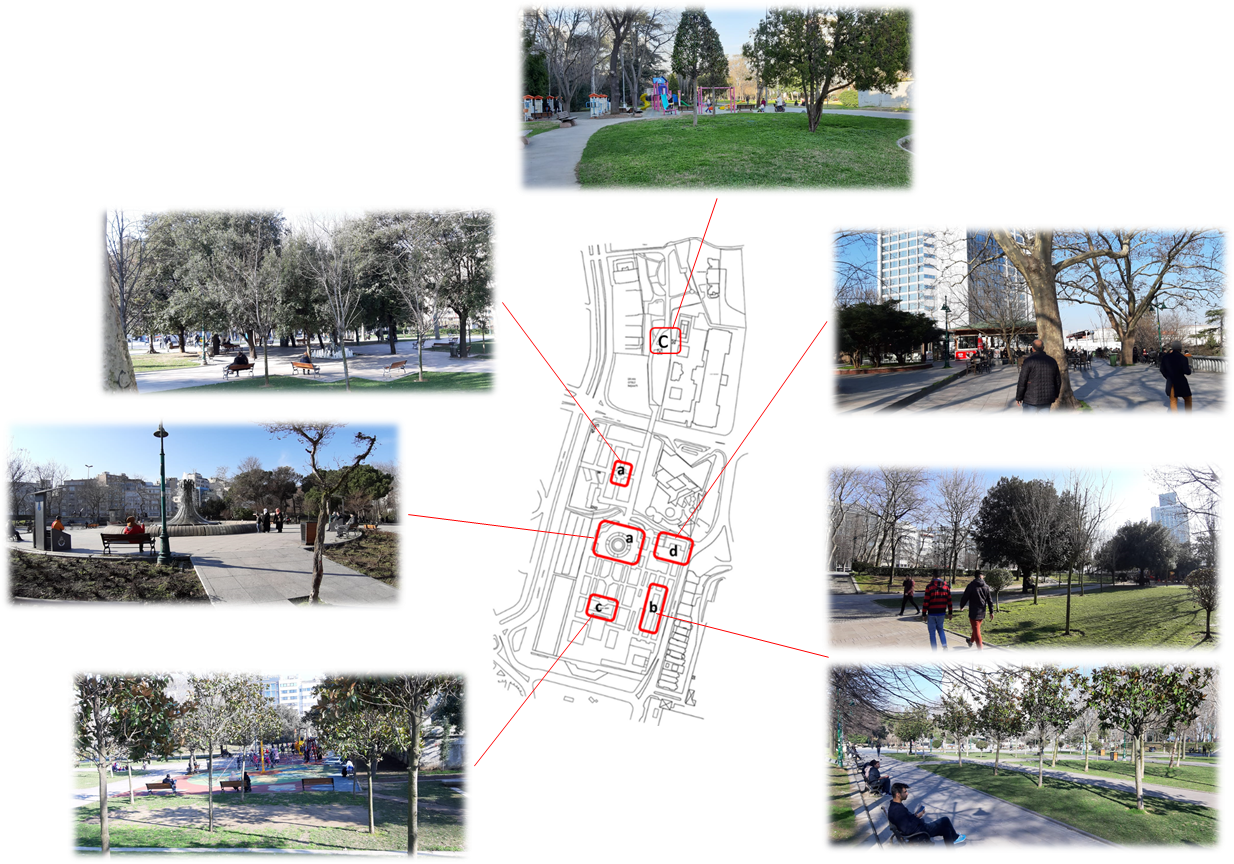 | Figure 2. Six parts of Taksim Gezi Park for Direct Field Observation |
In general, our results showed both groups (native and foreign) participants viewed cultural diversity as the most important cultural ecosystem service, social relations and sense of place came after aesthetic and recreation. The only difference between these two groups was the natives viewed recreation to be more important than aesthetics, while the foreigners considered aesthetics to be more important than recreation. Our result showed the high stated importance of cultural ecosystem services related to social activities. In general, all cultural ecosystem services are perceived as rather important. More findings highlighted more positive correlations between perceived importance for both groups as some studies show many positive links between cultural ecosystem services [1,9]. These contrasting results show the heterogeneous character of cultural ecosystem services valuation and the necessity for attention to detail.Earlier research has normally used questionnaire surveys to clarify usage patterns of green spaces. From this survey, the activities mostly undertaken by the native people in the park were walking for pleasure, sitting and relaxing, and observing greenery. Other important activities carried out were to meet and socialize with people, picnic, cycling, walking a dog, supervise and play with children, and finally to see domestic animals. For the foreign group, the most common activities performed by them were to sit and relax, walk for pleasure, and to observe greenery. Other important activities performed by the foreigners were to meet and socialize with people, jogging and running, picnic, and organized activities. The native group visited Taksim gezi park for different reasons, which include being in nature and for peace and quiet, with other significant reasons; for physical activities, to meet people, for its history and beauty. While the foreign people visited Taksim gezi park for its beauty, being in nature, for peace and quiet and history. Other significant reasons were for physical activities and to meet people. Previous research has established a comparable prevalence of more leisurely, recreation activities as primary incentives of using space. On a typical visit, both groups (natives and foreigners) tended to use this space mostly with friends. In addition, the foreign group stays in the park for a longer period h of time (thirty minutes to two hours was the popular option) than the native group (30 minutes to an hour was the popular option).Native mean importance of cultural ecosystem services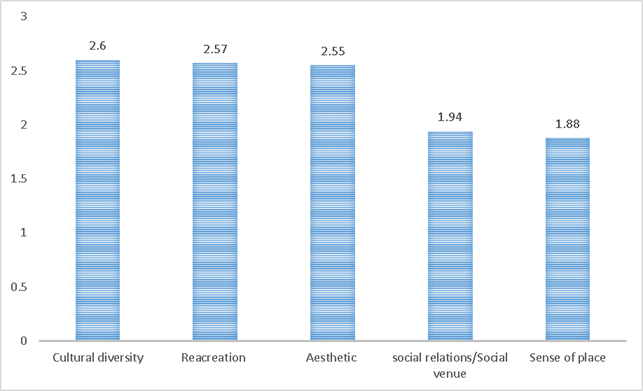 | Figure 3. Mean importance of cultural ecosystem services; scale from 1 (lowest) to 3 (highest importance) |
 | Figure 4. Bivariate correlation between stated importance of cultural ecosystem services across participants, (2-sided); (Strength of the arrows indicate the strength of person’s r coefficients) |
Foreigners mean importance of cultural ecosystem Services 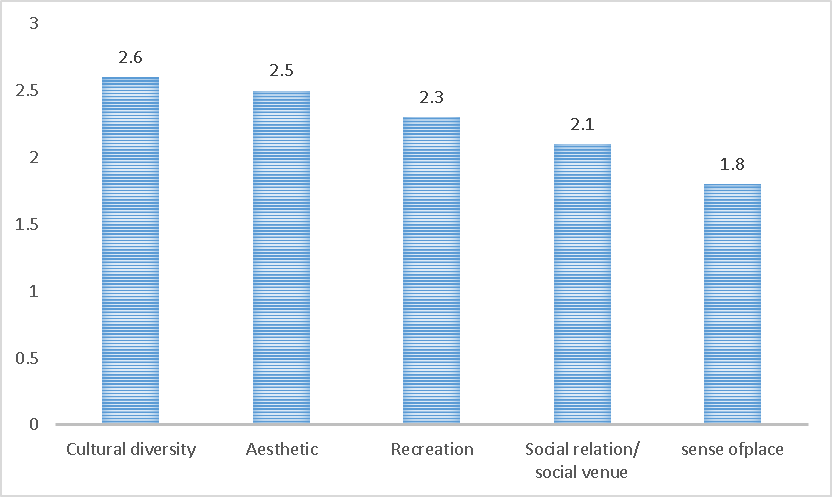 | Figure 5. Mean importance of cultural ecosystem services; scale from 1 (lowest) to 3 (highest importance) |
 | Figure 6. bivariate correlation between stated importance of cultural ecosystem services across participants, (2-sided); strength of the arrows indicates the strength of the person’s r coefficients |
Urban green space gives outdoor places to meet, particularly in densely populated areas. Yet, the use of urban green spaces for social relations; such as festivals or for active recreation may restrict and negatively influence cultural ecosystem services provision concerning contemplation and recreation [1]. These vary the demands and may lead to certain user-conflict due to a confined amount of green spaces areas. A better comprehension of urban cultural ecosystem services is essential for social sustainability and needs to be passed on to decision-makers and the public. Urban green spaces give ecosystem service benefits on several levels and providing to the quality of life of residents and the social justice of the city.Climate change and demographical changes will have a significant effect on the urban development of cities worldwide. Cities are facing pressure for densification, which will challenge the provision and planning of urban green spaces. Public dialog and discussion between administration and those affected are often challenging, yet significant usefulness can be established in creating a space to share and maybe shape opinions. The spatial distributions of social groups and their perception of cultural ecosystem services can be one method, which urban development and planning can be, enlightened. Broader studies of the importance and preferences of urban green spaces’ contributions to the non-material benefits as perceived by its residents, could be useful to tool to enlighten the heterogeneous and sometimes differing demands social groups can have. The group of urban cultural ecosystem services, as outlined in this research could improve data collection through a focus on cultural services without losing the diverseness character of the services.While there are several methods and approaches through which benefits from urban green spaces are assessed, we find the ecosystem services framework as an important tool to comprehensively survey quantitatively ecosystem services benefits and their distribution among the population. This research contributes to the existing literature on the benefits of urban green spaces by underlining, which cultural ecosystem services users perceive as important, and how much importance varies amongst social groups.
5. Conclusions
Cities are socially diverse. Perceived green space availability, CES provision, and perceptions are likely to reflect such diversity. In our study, we analyzed diverging perceptions of CES by social groups in Istanbul. This thesis relates to urban green space uses, particularly public parks, and their activity types and patterns. It considers the design features of urban green space, focusing on people’s activities and several forms of use. This research revealed fundamental social factors and the diverseness character of preferences of CES, which are essential for an in-depth understanding necessary to accurately enlighten political planning processes. Our results suggest various contrast concerning socio-demographic factors by two social groups: native inhabitants perceive recreational value more important than aesthetic value. Whereas the foreign users perceive aesthetics ahead of the recreation. These differences in perceptions should be considered when designing and planning of urban green spaces. Cultural differences, gender, age, and provision of ecosystem services, among others, should be cooperated with socially and spatially development schemes to allow for a socially just and sustainable city. Using site analysis and questionnaire surveys can be tools, which decision-makers can use to collect data on the importance of CES. Broader studies of the importance and preferences of urban green spaces’ contributions to the non-material benefits as perceived by its residents, could be a useful tool to enlighten the heterogeneous and sometimes differing demands social groups can have. The group of urban cultural ecosystem services, as outlined in this research could improve data collection through a focus on cultural services without losing the diverseness character of the services.While there are several methods and approaches through which benefits from urban green spaces are assessed, we find the ecosystem services framework as an important tool to comprehensively survey quantitatively ecosystem services benefits and their distribution among the population. This research contributes to the existing literature on the benefits of urban green spaces by underlining, which cultural ecosystem services users perceive as important, and how such importance varies amongst social groups. This information can be a key step to creating a connection particularly the dialogue between policymakers, planners, and inhabitants in the urban green space planning process, especially in the face of future challenges caused by biodiversity loss, demographical changes, and social inequalities.
Appendix
Table A1. 11 questionnaire items covering different CES aspects
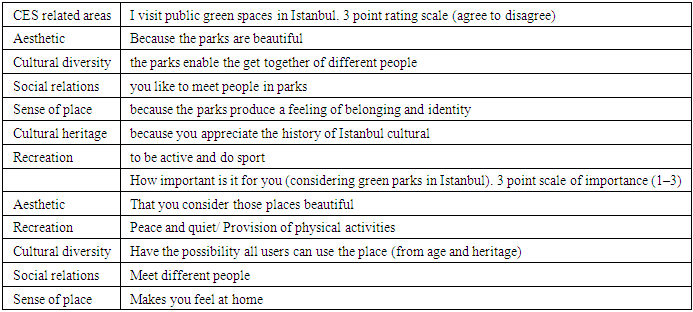 |
| |
|
Table A2. Native Bivariate correlations between CES variables across participants. Strength shown through Pearson’s r coefficient
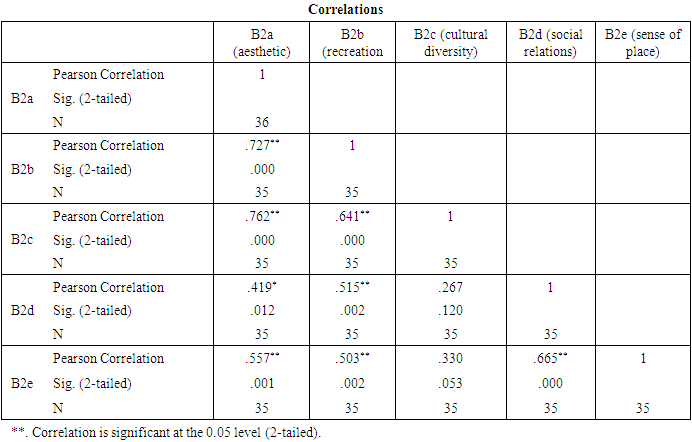 |
| |
|
Table A3. Native Bivariate correlations between CES variables across participants. The strength is shown through Pearson’s r coefficient
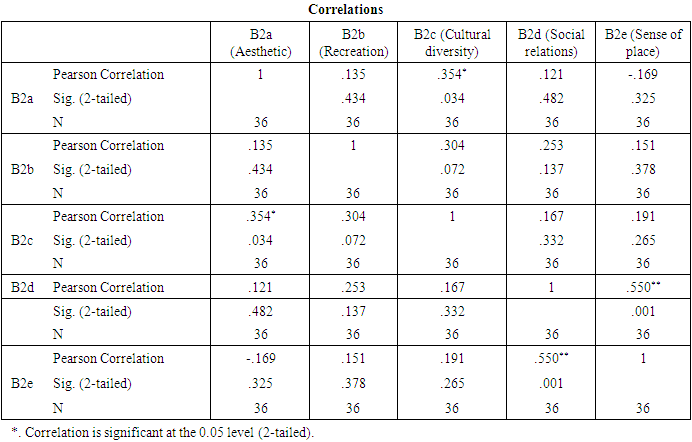 |
| |
|
References
| [1] | Bertram, C., & Rehdanz, K. (2015). Preferences for cultural urban ecosystem services: Comparing attitudes, perception, and use. Ecosystem Services, 12, 187–199. https://doi.org/10.1016/j.ecoser.2014.12.011. |
| [2] | Bolund, P., & Hunhammar, S. (1999). Ecosystem services in urban areas. 29, 293–301. |
| [3] | Chan, K. M. A., Goldstein, J., Satterfield, T., Hannahs, N., Kikiloi, K., Naidoo, R., Vadeboncoeur, N., & Woodside, U. (2011). Cultural services and non-use values. In P. Kareiva, H. Tallis, T. H. Ricketts, G. C. Daily, & S. Polasky (Eds.). Natural capital: Theory and practice of mapping ecosystem services (pp. 206–228). Oxford University Press. |
| [4] | Friggens, M., Raish, C., Finch, D., & Mcsweeney, A. (2015). The influence of personal belief, agency mission and city size on open space decision making processes in three southwestern cities. 577–598. https://doi.org/10.1007/s11252-014-0419-3. |
| [5] | Guo, Z., Zhang, L., & Li, Y. (2010). Increased Dependence of Humans on Ecosystem Services and Biodiversity. 5(10). https://doi.org/10.1371/journal.pone.0013113. |
| [6] | Millennium Ecosystem Assessment (2005). Ecosystems and human well-being: Synthesis. |
| [7] | Washington DC: Island Press. |
| [8] | Planning, U. (2014). Create account Sign in How can residents ’ experiences inform planning of urban green infrastructure? Case Finland. 1. |
| [9] | Plieninger, T., Dijks, S., Oteros-rozas, E., & Bieling, C. (2013). Create account Sign in Assessing, mapping, and quantifying cultural ecosystem services at community level. |
| [10] | Radford, K. G., & James, P. (2013). Create account Sign in Changes in the value of ecosystem services along a rural – urban gradient: A case study of Greater Manchester, UK. |
| [11] | World Bank. Urban Population https://blogs.worldbank.org/. |
| [12] | World Bank. (2016). Urban Population (% of Total). Download data [online] URL http://data.worldbank.org/indicator/SP.URB.TOTL.IN.ZS. Istanbul+population+and+demographic+structure. |









 Abstract
Abstract Reference
Reference Full-Text PDF
Full-Text PDF Full-text HTML
Full-text HTML



